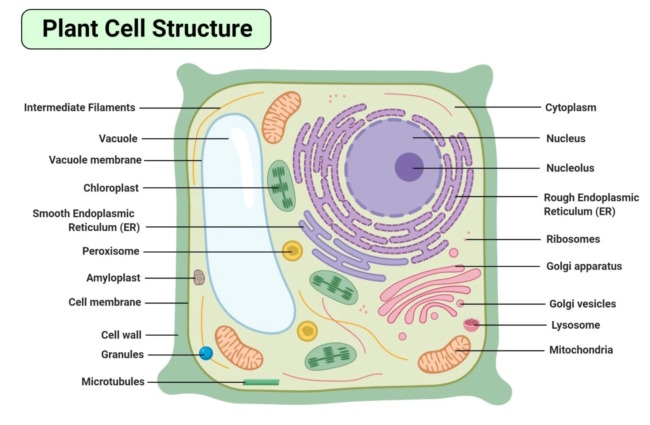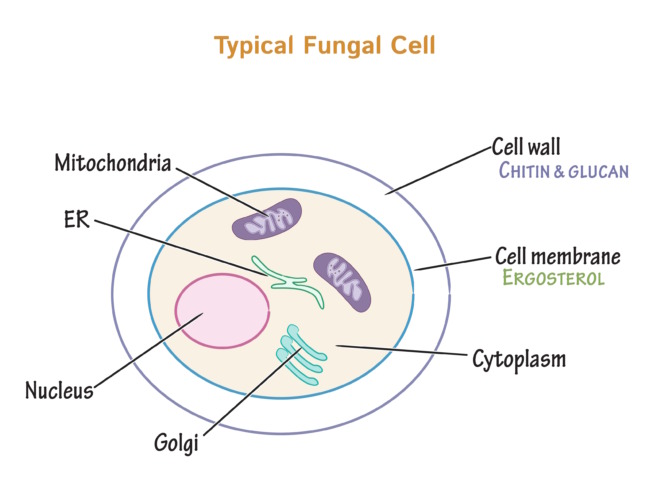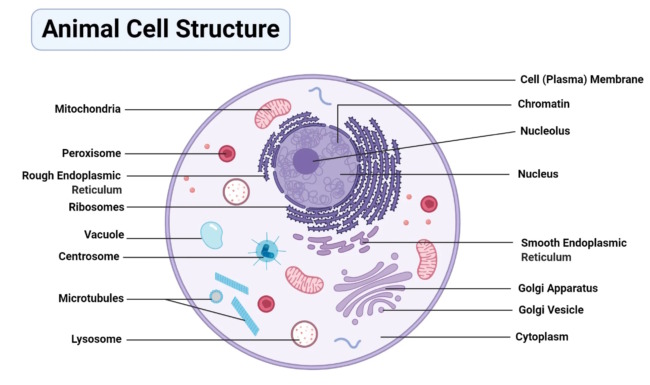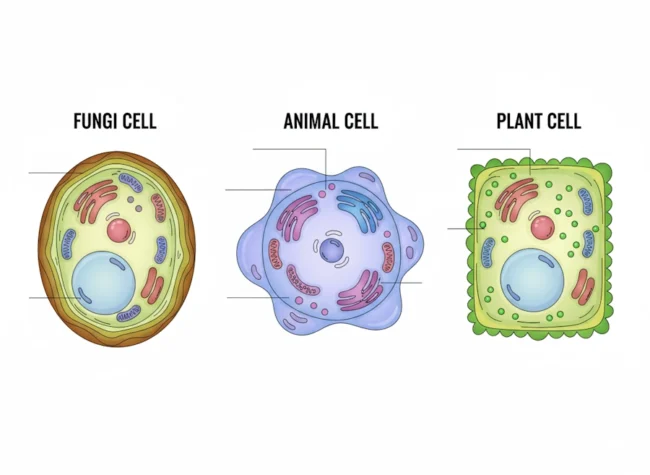Cells are the building blocks of life. Every living organism on Earth is made up of one or more cells. These tiny structures perform all the functions necessary for life, from providing energy to helping organisms grow and reproduce.
But did you know that cells can look and work differently depending on whether they belong to plants, mushrooms, or animals (including humans)?
Let’s explore how cells are built in these three groups of organisms.
What is a cell?
Before we dive into the differences, let’s start with the basics. A cell is like a tiny factory where everything happens to keep an organism alive. It has different parts called organelles, each with its own job. Some organelles store food, others produce energy, and some even act as cleanup crews!
There are two main types of cells:
- Prokaryotic cells: Basic cells that lack a nucleus, such as those found in bacteria.
- Eukaryotic cells: More complex cells with a nucleus and other specialized structures. Plants, fungi (mushrooms), and animals have eukaryotic cells.
Now, let’s take a closer look at how cells are built in plants, mushrooms, and animals.
All living organisms are made of cells, and while they come in different shapes and sizes, most share a few key parts:
- Cell Membrane: Think of this as the cell’s “skin.” It controls what enters and exits, like a bouncer at a club.
- Cytoplasm: A jelly-like fluid where all the cell’s machinery floats.
- Nucleus: The cell’s “brain.” It holds DNA, the instruction manual for life.
- Mitochondria: These organelles act as energy generators, converting nutrients into usable power for the cell.
- Ribosomes: Tiny factories that build proteins.
- Endoplasmic Reticulum (ER): A network of highways for making and transporting molecules.
– Rough ER: Covered in ribosomes, it makes proteins.
– Smooth ER: Makes fats and detoxifies chemicals. - Golgi Apparatus: The cell’s post office—packages and ships molecules.
- Cytoskeleton: A scaffold that gives the cell shape and helps it move.
Plant cells: the green factories
Structure of plant cells

Plant cells are unique because they help plants make their own food through photosynthesis. Here’s what makes them special:
- Cell Wall
Surrounding the cell membrane, the cell wall is a tough layer made mostly of cellulose. It gives plant cells their shape and protects them from damage.
Think of it like a sturdy brick wall around a house—it keeps things safe and stable. - Chloroplasts
Inside plant cells are green organelles called chloroplasts. They contain chlorophyll, which captures sunlight to make food during photosynthesis.
Without chloroplasts, plants wouldn’t be able to turn sunlight into sugar—a process essential for life on Earth! - Large Central Vacuole
Plant cells have a big storage space called a vacuole. This vacuole stores water, nutrients, and waste products. It also helps maintain pressure inside the cell so the plant stays upright.
Imagine it as a water balloon filling up the middle of the cell. - Nucleus
Like all eukaryotic cells, plant cells have a nucleus. This is the control center of the cell, holding DNA that tells the cell what to do. - Mitochondria
While chloroplasts handle energy production from sunlight, mitochondria are responsible for breaking down sugars to release energy when needed. - Plasmodesmata
Tiny channels called plasmodesmata connect neighboring plant cells. These allow materials to pass between cells, just like pipes connecting houses.
Fungal cells: the mighty decomposers
Structure of fungal cells

Mushrooms and other fungi play a crucial role in ecosystems by breaking down dead matter and recycling nutrients back into the soil. Their cells are quite different from those of plants and animals.
- Cell Wall (Made of Chitin)
Similar to plant cells, fungal cells have a cell wall, but instead of cellulose, it’s made of chitin—the same material found in insect exoskeletons!
This strong wall provides structure and protection. - No Chloroplasts
Unlike plants, fungi don’t have chloroplasts because they can’t perform photosynthesis. Instead, they absorb nutrients from their surroundings. - Hyphae and Mycelium
Fungi grow using thread-like structures called hyphae. Many hyphae together form a network called mycelium, which acts like roots to gather food.
Picture spaghetti strands spreading out under the ground. - Vacuoles
Fungal cells have smaller vacuoles compared to plant cells. These help regulate water balance and store substances like enzymes used for breaking down food. - Nucleus
Just like in plant and animal cells, the nucleus holds the genetic instructions for the fungus. - Septa
In many fungi, the hyphae are divided into sections by walls called septa. These walls have holes that let materials flow between sections.
Animal cells: the versatile workers
Structure of animal cells

Animal cells—including human cells—are incredibly versatile. They come in many shapes and sizes to suit their specific jobs, such as carrying oxygen, fighting infections, or transmitting signals.
- No Cell Wall
Unlike plant and fungal cells, animal cells lack a rigid cell wall. Instead, they’re surrounded only by a flexible cell membrane.
This flexibility allows animal cells to move and change shape easily. - Lysosomes
Animal cells contain lysosomes, which are like recycling centers. Lysosomes break down old or damaged parts of the cell and digest harmful invaders like bacteria.
Think of lysosomes as garbage trucks cleaning up the neighborhood. - Centrioles
During cell division, centrioles help organize the chromosomes and ensure each new cell gets the right amount of DNA.
Centrioles are exclusive to animal cells and are not found in plant or fungal cells. - Mitochondria
Since animals can’t make their own food like plants, their mitochondria are especially important. These powerhouses convert glucose into usable energy through cellular respiration. - Cilia and Flagella
Some animal cells have hair-like projections called cilia or whip-like tails called flagella. These help cells move or move substances along their surface.
For example, cilia in your lungs sweep mucus and dirt out of your airways. - Nucleus
As in plant and fungal cells, the nucleus controls the activities of the cell and stores DNA.
Key differences cell types
| Feature | Plant Cells | Fungal Cells | Animal Cells |
|---|---|---|---|
| Cell Wall | Yes (made of cellulose) | Yes (made of chitin) | No |
| Chloroplasts | Yes | No | No |
| Vacuole Size | Large central vacuole | Small vacuoles | Small or absent |
| Lysosomes | Rare | Rare | Common |
| Shape | Fixed, boxy | Variable | Flexible |
So what did we learn about cells?
Animal cells
- Animal cells form the foundation of every living animal.
- They have a flexible cell membrane but no rigid cell wall.
Important parts include:
- Nucleus: contains DNA and controls the cell
- Mitochondria: produce energy
- Ribosomes: make proteins
- Animal cells can have different shapes and are usually smaller than plant cells.
Fungal cells
- Fungi can be single-celled (like yeast) or multi-celled (like mushrooms).
- They have a rigid cell wall made of chitin, which gives them strength.
Fungi cells contain:
- A nucleus with DNA
- Mitochondria for energy
- No chloroplasts, so they can’t make their own food
- Many fungi grow as long threads called hyphae, which form a network called mycelium.
Plant cells
- Plant cells are found in all plants and are larger than animal cells.
- They have a rigid cell wall made of cellulose, which gives plants their structure.
Special features of plant cells include:
- Chloroplasts: help make food using sunlight
- Large vacuole: stores water and helps maintain cell shape
- Cell wall: provides extra protection and support
Similarities and differences
- All three types are eukaryotic cells, meaning they have a nucleus and other organelles.
- Animal and fungal cells don’t have chloroplasts, unlike plant cells.
- Fungi and plants have cell walls, but animals don’t.
- Animal cells are usually the most flexible in shape.
Remember, these different cell types help organisms survive in their unique environments! So next time you see a plant, eat a mushroom, or flex your muscles, remember—you’re witnessing the magic of cells at work!
Materials and sources we used to write this article:
- https://www.savemyexams.com/learning-hub/glossary/animal-cells-definition-functions-diagram/
- https://courses.lumenlearning.com/wm-biology2/chapter/fungal-structure-and-habitats/
- https://kids.britannica.com/kids/article/fungus/353159
- https://byjus.com/biology/animal-cell/
- https://bio.libretexts.org/Bookshelves/Introductory_and_General_Biology/General_Biology_(Boundless)/24:_Fungi/24.01:_Characteristics_of_Fungi/24.1B:_Fungi_Cell_Structure_and_Function
- https://www.youtube.com/watch?v=5PWcEpAHjGE
- https://www.bbc.co.uk/bitesize/guides/zxm3jty/revision/1
- https://www.youtube.com/watch?v=QcuPKy_Slng
- https://bio.libretexts.org/Bookshelves/Introductory_and_General_Biology/Introductory_Biology_(CK-12)/08:_Protists_and_Fungi/8.09:_Fungi_Structure

Leave a Reply